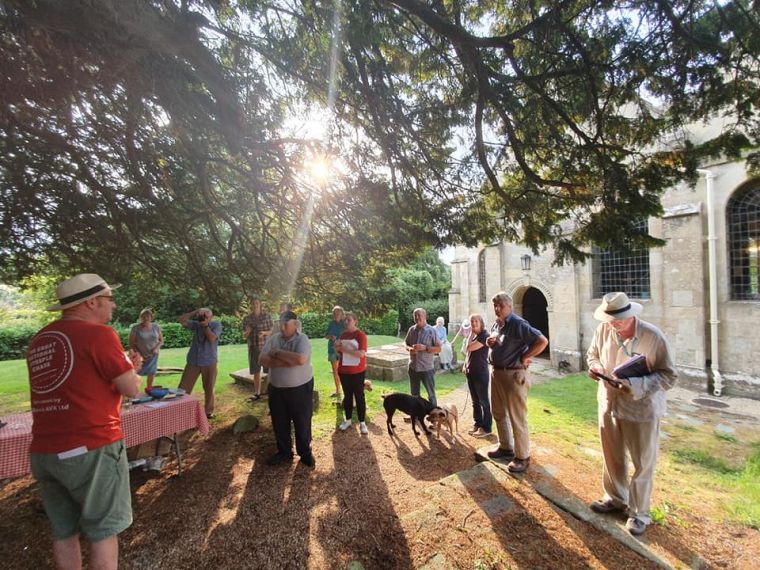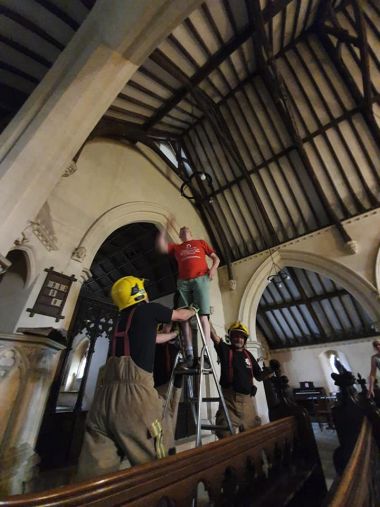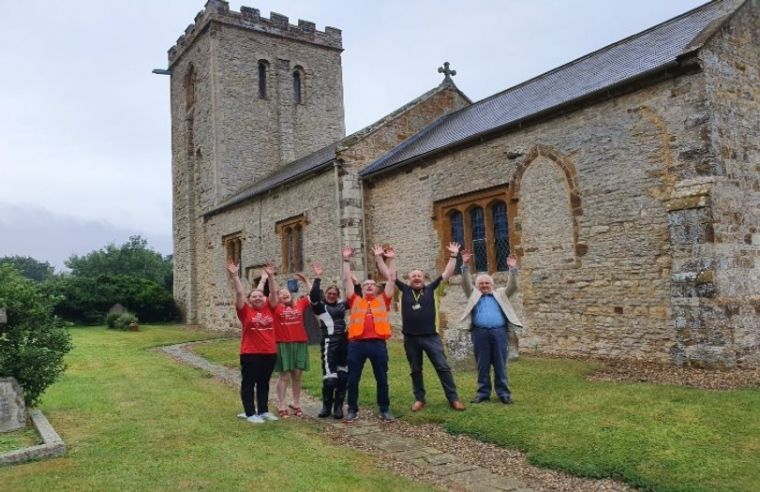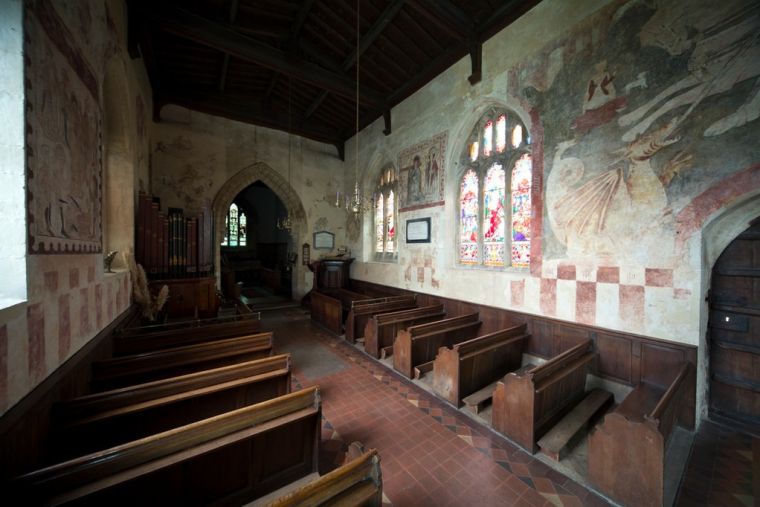With fewer worshipping communities, how can historic churches be preserved for generations to come?

Dotted across the English landscape are church spires, the architectural legacy of centuries of Christian faith. Tragically, with declining church attendance, many of these buildings - particularly those in rural areas - are at risk of closure or spiralling into an irreversible state of disrepair; the unique fabric, art and furnishings that many of them contain being lost along with them.
For decades, the Churches Conservation Trust has been working to save these precious national treasures and preserve them for future generations. In addition to restoration work, it raises awareness of the value of these buildings and invests in promoting them as places that are just as worth a visit as any stately home or castle.
This year, the trust has reached a milestone, celebrating its 50th anniversary, and has been busy fundraising to ensure the preservation of even more churches.
Peter Aiers, Chief Executive of Churches Conservation Trust, speaks to Christian Today about the CCT's work and what the next 50 years might look like.

CT: In terms of the conservation of historic church buildings, where do you start? What's the first thing to do in terms of getting to work in conserving the building?
Peter: We are very generously given all of our buildings by the Church of England, from the Church Commissioners, and they are given to us because there is not a viable worshipping community anymore, or because there are some significant problems with the building combined with some very significant historic value. All of our buildings are Grade I or Grade II* listed, so they are some of the most important historic buildings in the country.
We first have to work out what the repair needs of that building are and how long it will take to repair it. And at the same time, we begin to look at the local community and see how they might be engaged in the whole process because we don't want the building to be shut off; we want it to be open, very much so, when it's been repaired.
When we begin the process of repairing the building, we start by making sure it is thoroughly watertight. So, we repair all the roofs and the drainage system, because water is the biggest enemy of conservation and that causes more problems than anything else.
In addition to making sure the building is watertight, we conserve what we can. But really, every pound we spend when we receive the building saves about 10 later on because if you leave it, it just gets worse. So we put as much effort as we can in when we first get the building vested to us.
CT: So how far back does the history stretch with the churches that are in CCT's care?
Peter: We have buildings dating back to Saxon times and if you look carefully, there are some that are even older than that with pagan and pre-Christian artefacts and architecture. In our church in Brent, outside Wembley, there are bits of Roman hypocaust in the walls.
So they are very ancient. These are the buildings that tell the story of a place like no other can. There's well over 1,000 years of history embedded in the walls of our collection.
CT: How many churches do you have in your care? You must have some favourites.

Peter: We have 353 churches right across England and we get two or three new ones every year, so we'll have 356 by the end of the year and there's more coming our way. We'd take more on but there isn't any more money, so we're trying hard to raise more money.
I'm contractually obliged not to have any favourites of course! But some I could highlight are the majesty of St Nicholas, King's Lynn, which is cathedral-sized and absolutely glorious. All Souls, Bolton, is very dear to my heart because we spent a long time putting together a project there and it is a very modern intervention. It sits within the heart of an Asian Muslim community and we've called it All Souls for All Souls, a resource for the local community to use.
In St Mary-at-the-Quay in Ipswich, we've done a project about mental wellbeing and heritage with Suffolk Mind, while Aldwincle, in Northamptonshire, is the first church in the world to host 'champing' - church camping.
Personally, I have always liked St Peter's in Sandwich because that's where Thomas Paine was married. He wrote the Rights of Man and is a very interesting but underplayed figure in this country, but of course very important in France and the US.
CT: You mentioned engaging the local community. Do you find that the local community is enthusiastic about preserving the church?
Peter: It's interesting because usually the reason we have received the building in the first place is that the worshipping community hasn't been able to make that reach into the local community to keep the building going. And so it's usually mixed.
Sometimes the people who were in the worshipping community are feeling a bit exhausted and a bit sad that it's come to us. But generally, once we get talking to everyone, we try and get as many people involved as we possibly can and we've turned around a number of places where no one was interested to then later there being lots of events taking place in that building.
The key thing is that we're not saying that this is a 'CCT church'; we're saying this is your church, we're just going to help you look after it and if you can run events and raise money, that's briiliant because that will help look after more church buildings across the country as well.
CT: In that scenario, does the worshipping community remain there or are we talking about cultural events?
Peter: The buildings remain consecrated but they aren't open for regular worship; the regular Sunday worship doesn't take place anymore. But it is consecrated and we do think Christian worship is a really good use for a historic parish church, so it is always important that this can take place.
But there are a whole load of other activities that we encourage to take place, like theatre, music, beer festivals, cake eating - there is a huge amount of cake eating associated with churches, and tea as well!
CT: With churches closing all the time, do you think your workload is going to increase?
Peter: All across the country, there is a huge variety of things that regular parish churches do to engage people and keep the buildings going, but I think in some cases the demographics are against people. Almost all the most important historic churches in this country are in the countryside where there are the least people and these populations tend to be much older than the urban population.
In the countryside, far fewer people are going to church regularly as well than among the urban population. So the demographics are becoming older and it becomes more difficult to look after an old church.

Hence our new strategy, which is really aimed at trying to work out the best way to provide an infrastructure to support communities, whether Christian or secular. How can they be supported to look after these buildings in the future? Because there are going to be fewer worshipping communities in the countryside in the next 10 years and so I think the challenge to all of us who work with historic churches is: how do we support the communities out there to ensure that these buildings don't become irrelevant?
That's my biggest fear because these buildings are complicated. Religion can be very divisive and if these buildings are not used or loved then people will ask: what's the point in spending money on that building that's of no use to anybody?
It's really important we keep reinforcing the cultural value of these buildings. They hold the hopes and fears of communities over generations. There is no other building that has such a profound relationship with the place it is in than the historic parish church. It is the treasure of England, in my opinion, and they represent and tell the story of everybody, not just a few.
CT: How costly is it to restore a historic church?
Peter: When it comes to a major repair, they are very expensive and it depends how the building is used as well in terms of the ongoing costs. It's not beyond the wit of anyone to do it but the cost becomes crippling when the building gets out of control and you get a big repair bill that you weren't expecting.
On average, we usually spend around £300,000 on a new church coming into our portfolio. A new one we have just received, we had to spend around £1.3m on - what we would normally spend on three or four churches - but that was because the gutters and roof were very badly maintained.
There is a huge difference in cost if the building hasn't been looked after. The most important amount of money for historic churches to spend is on their annual maintenance. Unfortunately people don't like giving money for annual maintenance and they are more likely to give when there is a big issue.


But having said that, some of our buildings are in the middle of a field with no water supply and no electricity, and if you raise £2000 a year, you can look after that building. Every now and then, you would still need to repair the roof because the biggest problem we have is gravity, but generally speaking, you could look after that building for around £2,000 a year.
If I were able to put all of our money into an anti-gravity machine that might be a good result, but then again, that might not be the spirit of the charity!
CT: There must also be a lot of art in the churches?
Peter: We probably lost about 90 per cent of this country's religious art in the Reformation so we have got a lot less than other countries that didn't experience that but there are still the most amazing artefacts in our buildings, notwithstanding the many other historic buildings outside of the Churches Conservation Trust.
The art creates risk as well as cost. Medieval wall paintings are very precious. There is one in Broughton, near Milton Keynes, which has the most incredible collection of medieval wall paintings that were uncovered in the Victorian period. It's important to stay on top of them and make sure they're maintained well.
Inglesham in Wiltshire has some amazing paintings too but it had its lead roof stolen and that put the wall paintings at risk because of the water. Once these paintings are gone, they're gone.
But there are other risks too. A stained glass window was stolen from Withcote Chapel, in Leicstershire, made by Henry VIII's glazier who also did King's College in Cambridge. In Devon, someone stole parts of a 14th century rood screen, although we were really pleased we got those back.
Heritage crime is a huge issue, not only people stealing lead roofs but also stealing items of essentially public art. These belong to everybody, not a private collector, and to take them is the ultimate act of selfishness.

CT: Is it getting worse or does it just seem that way because there are often stories about it in the media?
Peter: I think it's always been going on. One of the buildings in our collection came to us in part because it had its lead stolen all the way back in 1946. It's not a recent phenomenon but people have got more methodical and faster at it and, ironically, Google Earth is helpful for identifying where lead roofs are.
The vast majority of people are deeply honest and wouldn't even think about trying to steal a lead roof or stained glass window or rood. It's not happening all the time but when it does happen, it is very devastating. At the moment we carry a £2m repair liability just for lead thefts from roofs - that's £2m on top of everything else we've got to spend to look after the churches.
When a lead roof has been stolen, we put a very good temporary roof on as quick as we can and then try to raise money to fix the problem. But when it comes to a piece of art, the impact is not so much financial. It's the fact that the art is irreplaceable.
We have got to try and protect our church roofs and it's not enough to be complacent. Lead roof alarms work and so it's worth the money to install them. We've got to make life more difficult for people trying to steal them. There are quite organised gangs out there stripping church roofs of their lead so get an alarm on your roof. It might seem like a lot of money but it will certainly save money later and you are better off in terms of your insurance too.
Sometimes people have only noticed their lead has been stolen when the rain is pouring in through the roof and, as I've said, water is the biggest enemy, so stopping people from taking the lead off in the first place is vital. We work with E-Bound who design alarm systems specifically for churches and they have been very successful at protecting churches across the country.

CT: CCT is going to host a debate at the V&A in September asking the question: who should be responsible for the care of historic churches? Are you able to say what your opinion on that is or do we have to wait until the debate to find out?!
Peter: I think it's definitely worth a debate! It is quite complicated and where does the responsibility fall? With a decline in congregations in places where the most historic churches are, whose responsibility is it? It's always been perceived as the Church's but the Church can think it's the community's. And people can think that the Church has a lot of money, so what are they spending that on?
The congregation can think it's the PCC's responsibility and ask why often elderly people who are just volunteers with no expertise in looking after historic buildings are being left with the burden of 12,000-odd historic churches. It is a complicated question.

CT: When the CCT started out 50 years ago it was only about preserving the building. Nowadays, the work has expanded to finding new uses for the building. How do you think the conservation work around historic churches has evolved over the last 50 years and where do you see it going in perhaps the next 50 years?
Peter: I think technically we have improved. How we specifically go about conserving buildings we've got a lot better at. If you look at some of the early buildings in our collection and some of the decisions that were made, they were fine at the time because there was a context for it, but through the lens of a modern eye we might think they were a bit odd now.
I have been speaking to lots of colleagues in Europe and the conservation world is coming round to this idea that perhaps people are really important to the future of conservation! That is especially the case with historic churches because if nobody loves them and nobody understands them, then there is no future for them. We rely on that love for the supply of people who care for them and the money that goes towards supporting them and perpetuating their use and relevance to the community.
Holland is facing a huge number of historic church closures. One colleague I spoke to there said he felt that conservation is moving away from the merely technical to addressing how we deal with communities and people and how they love these buildings.
Because ultimately, it's not very hard to repair a building; we know how to do that. But what's really hard to do is to ensure that there's a group of people around those buildings who are going to stick with them in the long term and care for them. It's that investment of time and effort by people which is where we are putting a lot of our effort now.
The Churches Conservation Trust debate takes place in the Lydia and Manfred Gorvy Lecture Theatre of the Victoria and Albert Museum on 3 September at 7.00pm (doors open at 6.30pm). Advance tickets are priced £25.00 for non-members and £23.00 for members. To book, visit the Churches Conservation Trust website











